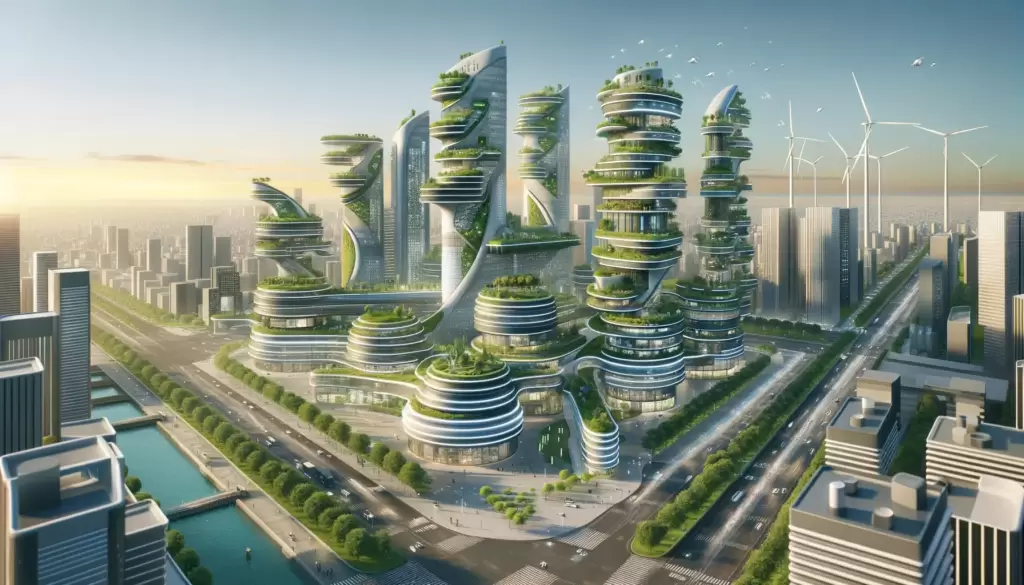
Table of Contents
The Rise of Sustainable Architecture
The rise of sustainable architecture marks a significant shift in the construction industry, with a growing emphasis on environmental consciousness and responsible design. As climate change becomes an increasingly urgent concern, architects are adopting innovative approaches to reduce the ecological impact of their buildings. This has led to a surge in the use of sustainable materials, energy-efficient designs, and green technologies that prioritize the well-being of both inhabitants and the planet.
Moreover, sustainable architecture is not just about reducing harm; it also offers exciting opportunities for creative expression and ingenuity. Architects are pushing boundaries by incorporating natural elements into their designs, such as living walls, green roofs, and passive heating and cooling systems. These features not only contribute to a healthier environment but also create aesthetically stunning spaces that seamlessly blend with their surroundings. The rise of sustainable architecture signals a transformative era where designers are reimagining the built environment as harmonious with nature rather than separate from it.
Past Trends: Traditional vs. Sustainable
In the past, traditional architecture focused on meeting immediate needs without a strong consideration for long-term environmental impact. As a result, many historical buildings and designs relied heavily on non-renewable resources and generated significant amounts of waste. However, sustainable architecture has emerged as a response to these unsustainable practices, emphasizing environmentally friendly design principles that prioritize energy efficiency, use of renewable materials, and minimal impact on natural resources.
The contrast between traditional and sustainable architecture extends beyond just the design process; it also encompasses cultural and societal values. Traditional architecture often reflects historical customs and regional aesthetics, while sustainable architecture integrates innovative technologies and global sustainability goals. The shift towards sustainable architecture represents a paradigmatic change in how we approach construction projects, moving away from a focus solely on aesthetics to an integrated view that considers the long-term health of our planet. By embracing sustainable practices, we have the opportunity to preserve cultural heritage while ensuring a more eco-friendly future for generations to come.
Current Innovations: Green Materials and Technology
The ever-evolving field of sustainable architecture is witnessing a surge in innovative green materials and technology that are reshaping the way we approach construction. One such breakthrough innovation is the development of bioplastics, which are derived from renewable sources such as corn, sugarcane, or cellulose. These biodegradable materials not only reduce reliance on traditional petroleum-based plastics but also offer architects and builders an eco-friendly alternative with versatile applications in design and construction.
In addition to novel materials, advancements in technology are revolutionizing sustainable architecture. The integration of smart glass technology, for instance, allows buildings to optimize natural light while controlling heat gain, thereby reducing energy consumption and enhancing occupant comfort. Furthermore, 3D printing technologies have made significant strides in using recycled materials to create complex architectural components with minimal waste—a promising step towards a circular economy within the construction industry. As these green innovations continue to proliferate, the future of sustainable architecture holds vast potential for creating environmentally conscious structures that harmonize with their surroundings while lessening their environmental impact.
Future Predictions: Net-Zero Buildings and Biophilic Design
Net-zero buildings and biophilic design are set to revolutionize sustainable architecture in the coming years. As technology advances, we can expect to see a surge in the construction of net-zero buildings, which generate as much energy as they consume. These structures will harness renewable energy sources such as solar power and use innovative materials to achieve maximum efficiency. Moreover, biophilic design principles, which incorporate natural elements into building spaces, are gaining traction for their ability to improve mental health and well-being. This trend could lead to an increase in green spaces within urban environments and a focus on promoting connections with nature within building interiors.
In addition, the integration of smart technologies within net-zero buildings will play a pivotal role in maximizing sustainability efforts. From automated climate control systems to real-time data analytics, these advancements will enable buildings to optimize resource consumption and minimize environmental impact. Furthermore, the rise of 3D printing technology is likely to revolutionize the construction industry by allowing for more efficient use of materials and reduced waste during the building process. These innovations signal an exciting future for sustainable architecture as we strive towards creating harmonious environments that coexist seamlessly with nature while minimizing our carbon footprint.
Challenges Ahead: Cost and Policy Barriers
As sustainable architecture gains momentum, new challenges emerge in the form of cost and policy barriers. The upfront investment required to implement sustainable design elements often poses a significant financial hurdle for builders and developers. High-quality, environmentally friendly materials and innovative technologies can come at a premium, making it difficult for some projects to justify the initial expenses. Additionally, navigating complex regulations and varying policies across different regions adds another layer of difficulty in achieving sustainable architectural goals.
One potential solution to address these challenges lies in fostering collaboration between industry stakeholders, policymakers, and financial institutions. By working together to incentivize sustainable construction through tax credits, rebates, or low-interest financing options, the financial burden on builders may be lightened. Furthermore, streamlining and standardizing green building codes could help create a more cohesive regulatory environment that encourages widespread adoption of sustainable practices across various jurisdictions. These collaborative efforts can pave the way for a more accessible and economically feasible path toward sustainable architecture in the future.
Global Impact: Sustainable Architecture as a Solution
Sustainable architecture has the potential to address some of the most pressing global challenges we face today. By integrating environmentally-friendly design and renewable energy systems, sustainable buildings can significantly reduce carbon emissions and environmental impact. Furthermore, sustainable architecture can also contribute to societal well-being by creating healthier living spaces and fostering a sense of community.
One of the most impactful aspects of sustainable architecture is its ability to inspire and influence other industries and individuals to adopt more eco-friendly practices. When iconic buildings showcase their commitment to sustainability through innovative designs and green technologies, it sends a powerful message that resonates globally. This ripple effect encourages other architects, developers, and city planners to prioritize sustainable solutions in their projects, ultimately driving positive change on a larger scale. In this way, sustainable architecture serves as a catalyst for broader environmental consciousness and action around the world.
Conclusion: Embracing the Potential of Sustainable Architecture
In conclusion, the potential of sustainable architecture is a powerful force shaping the future of our built environment. Embracing sustainable design principles not only benefits the environment but also contributes to the health and well-being of occupants. As we continue to innovate and push the boundaries of what is possible with sustainable architecture, we open up new opportunities for creating resilient, energy-efficient, and aesthetically pleasing structures.
Furthermore, embracing the potential of sustainable architecture allows us to reconsider traditional construction methods and materials, leading to a more holistic approach that minimizes waste and reduces carbon emissions. By prioritizing sustainability in our designs, we can inspire a shift towards a more environmentally conscious society while meeting the challenges of urbanization and climate change head-on. The future of sustainable architecture holds promise for creating harmonious spaces that enhance both human experience and ecological balance.


